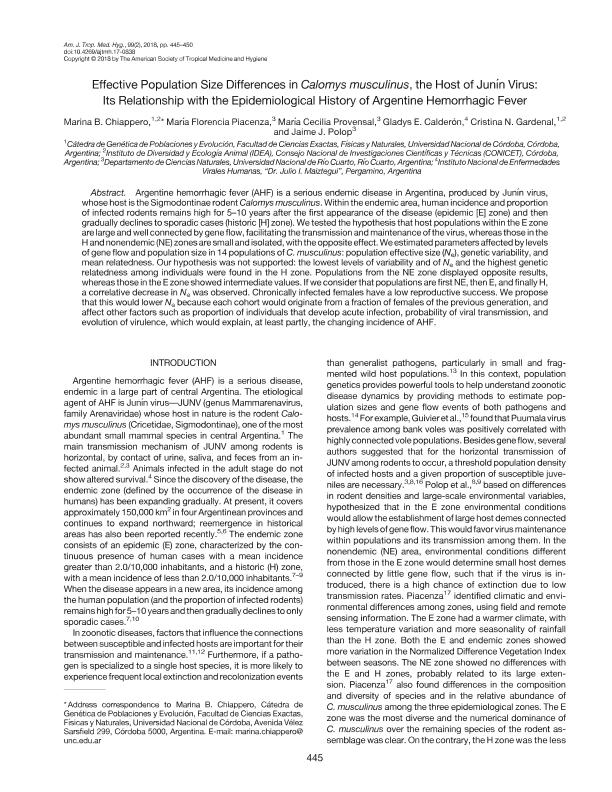Mostrar el registro sencillo del ítem
dc.contributor.author
Chiappero, Marina Beatriz

dc.contributor.author
Piacenza, Maria Florencia

dc.contributor.author
Provensal, María Cecilia

dc.contributor.author
Calderón, Gladys Ethel

dc.contributor.author
Gardenal, Cristina Noemi

dc.contributor.author
Polop, Jaime Jose

dc.date.available
2019-11-12T15:00:09Z
dc.date.issued
2018-10
dc.identifier.citation
Chiappero, Marina Beatriz; Piacenza, Maria Florencia; Provensal, María Cecilia; Calderón, Gladys Ethel; Gardenal, Cristina Noemi; et al.; Effective population size differences in calomys musculinus, the host of Junín Virus: Their relationship with the epidemiological history of argentine hemorrhagic fever; American Society of Tropical Medicine and Hygiene; American Journal of Tropical Medicine and Hygiene; 99; 2; 10-2018; 445-450
dc.identifier.issn
0002-9637
dc.identifier.uri
http://hdl.handle.net/11336/88612
dc.description.abstract
Argentine hemorrhagic fever (AHF) is a serious endemic disease in Argentina, produced by Junín virus, whose host is the Sigmodontinae rodent Calomys musculinus. Within the endemic area, human incidence and proportion of infected rodents remains high for 5-10 years after the first appearance of the disease (epidemic [E] zone) and then gradually declines to sporadic cases (historic [H] zone). We tested the hypothesis that host populations within the E zone are large and well connected by gene flow, facilitating the transmission and maintenance of the virus, whereas those in the H and nonendemic (NE) zones are small and isolated, with the opposite effect. We estimated parameters affected by levels of gene flow and population size in 14 populations of C. musculinus: population effective size (Ne), genetic variability, and mean relatedness. Our hypothesis was not supported: the lowest levels of variability and of Ne and the highest genetic relatedness among individuals were found in the H zone. Populations from the NE zone displayed opposite results, whereas those in the E zone showed intermediate values. If we consider that populations are first NE, then E, and finally H, a correlative decrease in Ne was observed. Chronically infected females have a low reproductive success. We propose that this would lower Ne because each cohort would originate from a fraction of females of the previous generation, and affect other factors such as proportion of individuals that develop acute infection, probability of viral transmission, and evolution of virulence, which would explain, at least partly, the changing incidence of AHF.
dc.format
application/pdf
dc.language.iso
eng
dc.publisher
American Society of Tropical Medicine and Hygiene

dc.rights
info:eu-repo/semantics/openAccess
dc.rights.uri
https://creativecommons.org/licenses/by-nc-sa/2.5/ar/
dc.subject
ARGENTINE HEMORRHAGIC FEVER
dc.subject
CALOMYS MUSCULINUS
dc.subject
POPULATION EFFECTIVE SIZE
dc.subject
VIRAL TRANSMISSION
dc.subject.classification
Genética y Herencia

dc.subject.classification
Ciencias Biológicas

dc.subject.classification
CIENCIAS NATURALES Y EXACTAS

dc.title
Effective population size differences in calomys musculinus, the host of Junín Virus: Their relationship with the epidemiological history of argentine hemorrhagic fever
dc.type
info:eu-repo/semantics/article
dc.type
info:ar-repo/semantics/artículo
dc.type
info:eu-repo/semantics/publishedVersion
dc.date.updated
2019-10-16T14:26:56Z
dc.identifier.eissn
1476-1645
dc.journal.volume
99
dc.journal.number
2
dc.journal.pagination
445-450
dc.journal.pais
Estados Unidos

dc.journal.ciudad
Stanford
dc.description.fil
Fil: Chiappero, Marina Beatriz. Consejo Nacional de Investigaciones Científicas y Técnicas. Centro Científico Tecnológico Conicet - Córdoba. Instituto de Diversidad y Ecología Animal. Universidad Nacional de Córdoba. Facultad de Ciencias Exactas Físicas y Naturales. Instituto de Diversidad y Ecología Animal; Argentina
dc.description.fil
Fil: Piacenza, Maria Florencia. Universidad Nacional de Río Cuarto. Facultad de Ciencias Exactas, Fisicoquímicas y Naturales. Departamento de Ciencias Naturales; Argentina
dc.description.fil
Fil: Provensal, María Cecilia. Universidad Nacional de Río Cuarto; Argentina
dc.description.fil
Fil: Calderón, Gladys Ethel. Instituto Nacional de Enfermedades Virales Humanas Dr. Julio I. Maiztegui; Argentina
dc.description.fil
Fil: Gardenal, Cristina Noemi. Consejo Nacional de Investigaciones Científicas y Técnicas. Centro Científico Tecnológico Conicet - Córdoba. Instituto de Diversidad y Ecología Animal. Universidad Nacional de Córdoba. Facultad de Ciencias Exactas Físicas y Naturales. Instituto de Diversidad y Ecología Animal; Argentina
dc.description.fil
Fil: Polop, Jaime Jose. Universidad Nacional de Río Cuarto; Argentina
dc.journal.title
American Journal of Tropical Medicine and Hygiene

dc.relation.alternativeid
info:eu-repo/semantics/altIdentifier/doi/http://dx.doi.org/10.4269/ajtmh.17-0838
dc.relation.alternativeid
info:eu-repo/semantics/altIdentifier/url/http://www.ajtmh.org/content/journals/10.4269/ajtmh.17-0838
Archivos asociados
